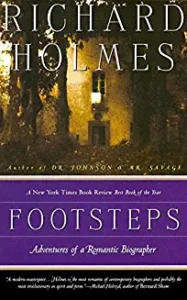Footsteps: Adventures of a Romantic Biographer by Richard Holmes 1985
I came across this book at my favorite used bookstore, The Bryn Mawr on Huron Avenue in Cambridge. It’s a store that I frequented between 1971-1973 when we lived three blocks down the street, and I still have a few old tattered paperbacks priced at 25 cents on the inside cover from those days. Having moved back to the old neighborhood in 2004, I still find that browsing in this tiny, cramped, musty place to be delightful.
This book caught my eye because I had read and very much enjoyed Holmes’ 2016 memoir which focused on the topic of writing biography through walking in the subject’s footsteps. Holmes, a renowned British biographer of the Romantic poets, became enamored of this period while a young student at Cambridge and soon developed his own technique for writing biography. He seeks to immerse himself in the world of his subject, walking in her footsteps, living in the places his subject lived, and using the letters and marginalia of his subjects to merge his soul with theirs. As he writes, “...the biographical process became an instrument of moral precision and analysis—a way of making sense of my own world.” The result has been classic studies of Shelley, Coleridge, and Keats and this book, the first of his three memoirs.
In four chapters dated 1964, 1968, 1972, and 1976, Holmes moves from events in his life to travels taken by Robert Louis Stevenson, Mary Wollstonecraft, Percy Shelley, and a new figure for me, Gerard de Nerval, a French poet and travel writer who committed suicide in 1855. All of these figures were active in the 50 years after the French Revolution and their lives reflected the revolutionary ideals of the period—individual liberty, empowerment. equality, justice.
This book was about 50% wonderful and 50% slog. Each chapter began with energy, enthusiasm, information, and vivid language but about halfway through, Holmes succumbed to the biographer’s dilemma—how to share each and every detail and tidbit discovered during the years of delving into the subject’s life and world in a selective and not completist manner. Like the recently published 1000 page door-stop bios of figures as diverse as U.S. Grant and Tom Stoppard, this book became bogged down in details, in this case the endless quotations from letters between Shelley and Claire Clairmont or between Nerval and Theophile Gautier. Some selection and prudent pruning by the editor could have resulted in a book of half the length and twice the interest.
Nonetheless, Holmes is worth reading especially if you’re a devotee of the Romantic period. He writes with style about his subjects living and writing in a fascinating world of change and upheaval.



